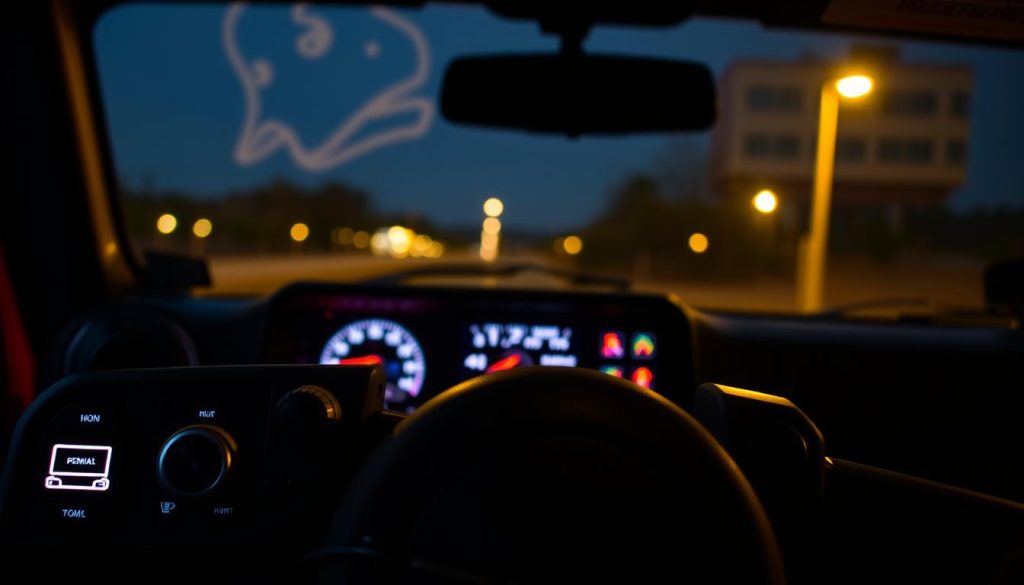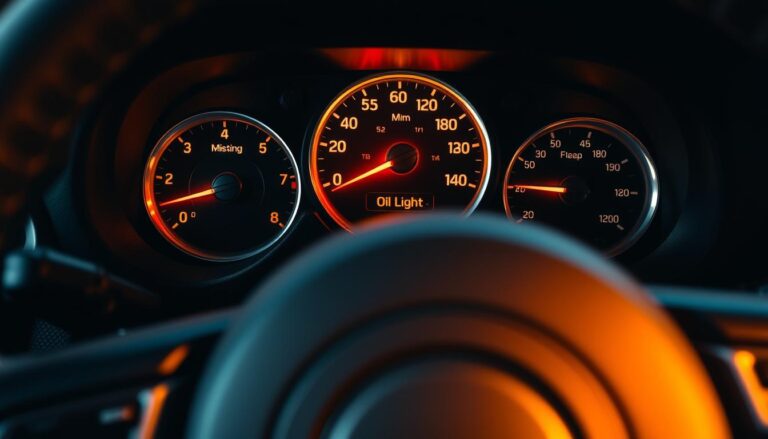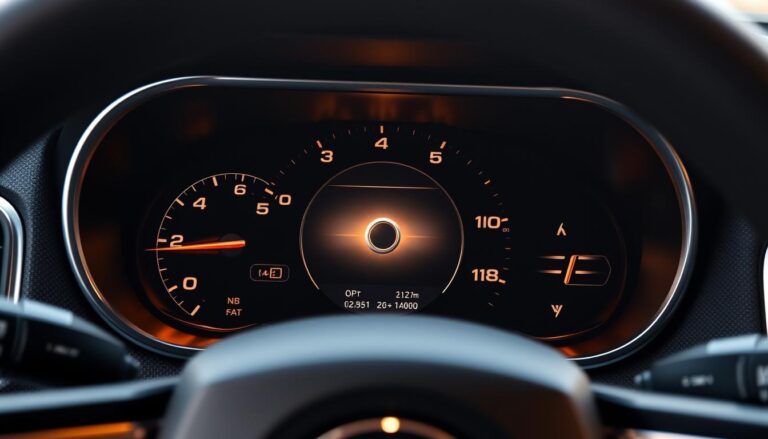The comprehension of the Jeep lighting system is paramount for a secure and pleasurable driving experience. Mastery over the illumination within your vehicle transcends mere convenience; it embodies a fundamental component of vehicular upkeep.
For those unacquainted with the Jeep light controls, the dashboard’s complexity can be overwhelming. Yet, upon mastering the operation of the lighting system, one’s confidence in driving is significantly enhanced, ensuring control over the vehicle’s luminosity.
To further your knowledge on managing dashboard alerts, such as the gas cap light, refer to our comprehensive guide on how to rectify the gas cap light on your Jeep.
Key Takeaways
- Comprehension of your Jeep’s lighting system is essential for an enhanced driving experience.
- Acquaintance with the Jeep light controls facilitates easier navigation.
- Effective illumination management is a critical component of vehicular maintenance.
- Control over your vehicle’s lighting ensures safer driving conditions.
- Consult guides for managing other dashboard alerts, such as the gas cap light.
Understanding Your Jeep’s Lighting System
The complexity of your Jeep’s lighting system significantly impacts your driving experience. It is a pivotal component, ensuring visibility, safety, and convenience. The system integrates various lights, controls, and automatic functionalities, collectively illuminating your path.
Types of Lights in Different Jeep Models
Jeep models exhibit diverse lighting configurations. These include headlights, fog lights, running lights, and interior dome lights. For example, the Wrangler and Gladiator models feature round headlights, whereas the Cherokee and Grand Cherokee showcase more angular designs. Below is a table detailing the common lighting configurations across various Jeep models.
| Jeep Model | Headlights | Fog Lights | Running Lights |
|---|---|---|---|
| Wrangler | Round | Optional | Standard |
| Gladiator | Round | Optional | Standard |
| Cherokee | Angular | Standard | Standard |
Location of Light Controls and Switches
The controls for your Jeep’s lighting system are generally situated on the dashboard or steering column. The light switch or control panel enables you to modify the lighting settings as needed. Understanding the location and operation of these controls is crucial for safe and convenient driving.

How Jeep’s Automatic Lighting Features Work
Modern Jeep models often feature automatic lighting features that adjust lighting based on ambient conditions. These include automatic headlights, daytime running lights, and adaptive lighting systems. These technologies enhance safety and convenience by ensuring that your vehicle’s lights are optimally adjusted at all times.
How to Turn Lights Off in Jeep: Step-by-Step Guide
Mastering the control and deactivation of your Jeep’s lighting systems is paramount for both efficiency and safety on the road. The illumination system in your Jeep is engineered to enhance visibility and safety, yet it is equally crucial to manage these lights to prevent battery drain.
Turning Off Headlights and Running Lights
To deactivate the headlights in your Jeep, first, confirm that you are in the appropriate mode. For most Jeep models, the headlights can be switched off by rotating the light control knob to the ‘OFF’ position. If your Jeep is equipped with automatic headlights, you may need to adjust the settings in your vehicle’s menu to disable this feature when it’s not needed.
Steps to Turn Off Headlights:
- Locate the light control knob on your dashboard.
- Rotate the knob to the ‘OFF’ position.
- If your Jeep has automatic headlights, check your settings menu to disable them when not in use.
Running lights, often referred to as daytime running lights (DRLs), are designed to be always on when the vehicle is running. Yet, some Jeep models allow you to disable DRLs through the vehicle’s settings menu.
Disabling Interior Dome and Map Lights
Interior dome and map lights can be controlled manually. To turn them off, simply switch the respective controls to the ‘OFF’ position. Many Jeep models come with a dome light override feature that can be activated by pressing and holding the dome light button.
Steps to Disable Interior Lights:
- Locate the dome light and map light controls.
- Switch the controls to the ‘OFF’ position.
- For dome light override, press and hold the dome light button until the lights turn off.

Managing Dashboard and Instrument Panel Illumination
Dashboard and instrument panel illumination can usually be adjusted or turned off using the lighting control knob or through the vehicle’s infotainment system. Rotating the knob counterclockwise typically dims the lights.
Steps to Adjust Dashboard Illumination:
- Locate the lighting control knob.
- Rotate the knob counterclockwise to dim the dashboard lights.
- Use the infotainment system to adjust or turn off the illumination if available.
Fog Lights and Auxiliary Lighting Controls
Fog lights are typically controlled by a separate switch and can be turned off by switching them to the ‘OFF’ position. Auxiliary lighting, if installed, may have its own controls or may be integrated into the vehicle’s lighting system.
Steps to Turn Off Fog Lights:
- Locate the fog light switch.
- Switch the fog lights to the ‘OFF’ position.
| Light Type | Control Method | Steps to Turn Off |
|---|---|---|
| Headlights | Light Control Knob | Rotate to ‘OFF’ |
| Interior Dome/Map Lights | Manual Switch | Switch to ‘OFF’ |
| Dashboard Illumination | Lighting Control Knob/Infotainment System | Rotate counterclockwise or adjust via infotainment |
| Fog Lights | Fog Light Switch | Switch to ‘OFF’ |
Troubleshooting Persistent Light Issues
When your Jeep’s lights persistently remain illuminated, it is imperative to identify the underlying cause to avert battery depletion. Such persistent light issues can arise from a multitude of factors, including malfunctioning door switches, electrical system malfunctions, or problems with the lighting control module.
Lights Staying On After Vehicle Is Off
Should your Jeep’s lights persistently illuminate post-engine shutdown, it can precipitously deplete the battery. This predicament often emanates from the vehicle’s electrical system. It is crucial to scrutinize your Jeep’s light controls to ascertain their operational integrity. A mere adjustment or a verification of the settings may suffice to rectify the issue.
To initiate troubleshooting, commence by examining the dashboard and interior lights. Verify that all doors are securely closed, and the dome light switch is not inadvertently stuck. Should the problem endure, it may necessitate an inspection of the door switches and sensors.
Diagnosing Faulty Door Switches and Sensors
Malfunctioning door switches and sensors can perpetuate the issue of lights remaining on. Inspect the door switches for any signs of wear or damage. Cleaning or replacing these switches may often resolve the issue. Concurrently, verify the sensors that govern the lighting system to ensure their operational integrity.
For example, a faulty door ajar sensor may persistently signal the lighting system to maintain illumination, even when the doors are ostensibly closed.
| Component | Possible Issue | Solution |
|---|---|---|
| Door Switches | Faulty or worn out | Clean or replace |
| Door Ajar Sensor | Malfunctioning | Inspect and replace if necessary |
| Lighting Control Module | Software glitch or hardware failure | Reset or replace the module |
Addressing Electrical Problems and Blown Fuses
Electrical malfunctions or blown fuses can also precipitate lighting issues. Inspect your Jeep’s fuse box for any blown fuses pertinent to the lighting system. Replacing a blown fuse may often rectify the problem.
In the event of suspected electrical malfunctions, it is advisable to seek the expertise of a professional mechanic for diagnosis and repair.
Emergency Solutions to Prevent Battery Drain
To avert battery drain when your Jeep’s lights persistently remain on, several emergency measures can be employed. Disconnection of the battery or utilization of a battery disconnect switch can serve as a temporary solution. Concurrently, employing a trickle charger or jump starter can provide a temporary reprieve.
By comprehending and addressing the root cause of persistent light issues, you can ensure the efficient operation of your Jeep’s electrical system, thus averting unnecessary battery drain.
Model-Specific Light Control Features
Jeep’s diverse lineup is distinguished by unique lighting attributes, tailored to the distinct requirements and aesthetics of each model. Grasping these nuances is imperative for optimal functionality and troubleshooting.
Wrangler and Gladiator Light Systems
The Wrangler and Gladiator embody ruggedness and off-road prowess. Their lighting systems are crafted to augment these attributes. The Wrangler boasts advanced lighting controls, such as automatic headlights and fog lights, which elevate visibility during off-road excursions. The Gladiator, in parallel, is equipped with a formidable lighting ensemble, including LED headlights and fog lights, engineered to endure extreme environments.
Cherokee and Grand Cherokee Light Controls
The Cherokee and Grand Cherokee showcase sophisticated lighting systems, bespoke to their unique configurations. The Grand Cherokee, exemplifying cutting-edge LED lighting technology, incorporates automatic headlights and daytime running lights. The Cherokee, too, presents versatile lighting controls, allowing drivers to tailor the illumination to various driving scenarios.
- Automatic headlights for enhanced safety
- Daytime running lights for increased visibility
- Customizable lighting settings for various driving conditions
Compass and Renegade Lighting Differences
The Compass and Renegade, though both compact SUVs, exhibit distinct lighting attributes. The Compass offers a spectrum of lighting options, including LED headlights and fog lights, optimized for urban and suburban environments. The Renegade, with its more rugged demeanor, features lighting controls that are both practical and resilient, aligning with its adventurous ethos.
A Jeep connoisseur observes, “The lighting systems in Jeep models are engineered to merge functionality with aesthetics, ensuring drivers enjoy an unparalleled experience on and off the road.”
“The lighting systems in Jeep models are engineered to merge functionality with aesthetics, ensuring drivers enjoy an unparalleled experience on and off the road.”
Conclusion
The intricacies of the Jeep lighting system necessitate a comprehensive grasp of its operation to safeguard the vehicle’s electrical integrity and avert battery depletion. The system encompasses a myriad of components, including headlights, fog lights, and interior illumination. Acquaintance with the positioning of light controls and switches, alongside the functionality of automatic lighting features, is paramount for adept management of the Jeep’s illumination setup.
Confrontation with persistent illumination issues in your Jeep mandates a thorough diagnostic approach. Inspect the integrity of door switches, sensors, and the electrical circuitry for potential malfunctions. In some instances, rectification may entail the removal of a fuse or the substitution of a defective relay. For scenarios demanding more sophisticated interventions, recourse to a professional mechanic or consultation with resources such as Hella Bulbs becomes imperative.
Adherence to the methodologies delineated within this discourse, coupled with a profound comprehension of your Jeep’s lighting apparatus, ensures the optimal functionality and energy efficiency of your vehicle’s illumination system. Such prudent management not only mitigates battery drain but also diminishes the likelihood of electrical malfunctions.
FAQ
How do I turn off the headlights in my Jeep?
To extinguish the headlights, first locate the headlight switch, situated on the left aspect of the steering column. Rotate it to the “Off” position to deactivate the headlights. In certain Jeep models, such as the Wrangler, pressing the “Auto” button is necessary to disable the automatic headlights.
Why are my Jeep’s interior lights staying on after I’ve turned off the engine?
Interior lights persisting after engine shutdown necessitate an examination of the door switches for any obstructions or damage. Verify the dome light switch’s position as well. Persistent issues may indicate a faulty sensor or an electrical malfunction, necessitating a comprehensive diagnostic evaluation.
Can I disable the automatic lighting features in my Jeep?
Disabling the automatic lighting features in your Jeep is feasible. Refer to your owner’s manual for specific guidance, as the procedure may differ across models. Generally, accessing the settings menu on your infotainment system or adjusting the light switch to override the automatic mode is required.
How do I manage the dashboard illumination in my Jeep?
To modify the dashboard illumination, locate the instrument panel dimmer control, typically situated on the center console or the light switch. Rotate the control to adjust the brightness to your liking. Some Jeep models offer an “Auto” mode, which adjusts illumination based on ambient light conditions.
What should I do if my Jeep’s fog lights won’t turn off?
Should your Jeep’s fog lights persistently remain illuminated, inspect the fog light switch for any malfunctions. Ensure it is set to the “Off” position. Persistent issues may indicate a faulty relay or electrical fault. Consult your owner’s manual or seek assistance from a Jeep dealership for further guidance.
Are there any model-specific lighting features I should be aware of in my Jeep?
Yes, various Jeep models incorporate unique lighting features. For instance, the Wrangler and Gladiator boast distinct light systems, whereas the Cherokee and Grand Cherokee possess their own light control functionalities. Refer to your owner’s manual or research your specific Jeep model to comprehend its lighting configuration.


